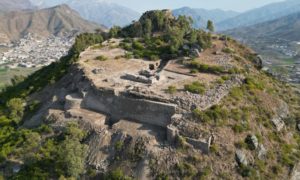It’s a sight to behold ― three young women working intently on a pair of centuries-old, towering wooden statues. They are chipping away at a sun-faded coat of paint in one corner of the workshop, and using resin to fill in a pocket of wormholes in another.
Protection and preservation
The trio in their 30s ― Naka Ai, Imura Kasumi, and Morisaki Reiko, ― make up Sanjoudou, a wooden Buddha restoration workshop. They set it up seven years ago to help protect Japan’s cultural heritage.
Naka and Imura are graduates from the Conservation of Wooden Sculptures course at the Tokyo University of the Arts, while Morisaki studied Media Arts at Toyama University.


The women first met in 2015 at the World Heritage site Nikko, in Tochigi Prefecture, where they were helping to restore 7.5-meter-tall Buddha statues at Nikko Rinnoji Temple.
After the two-year project ended, the trio faced a harsh reality: the scarcity of jobs for specialized restorers. The organization that contracted them was, at that time, the only employer of wooden Buddha restorers in Japan that was entrusted to work on culturally significant monuments and structures. And it wasn’t hiring.
“We simply wanted to continue doing restoration work, so I suggested that we start our own company,” recalls Naka. Imura and Morisaki promptly agreed.

They called their venture Sanjoudou, which in Japanese means “combining the power of three” and based themselves in Kanuma, a small city near Nikko known for its lumber mills and timber industry.
News of their unique enterprise soon spread via social and local media. “Inquiries started trickling in, and I was surprised that other than temples, individual owners of Buddha statues were also looking for restoration services,” says Morisaki.
They received and attended to all kinds of requests. One owner of a small Kannon Goddess of Mercy statue wanted the Goddess’ face to resemble a relative that had passed on.
As Sanjoudou gained a reputation for its skilled professionalism, small temple owners asked for help. Over the past seven years, the women have worked on more than 70 wooden Buddha statues throughout Japan.

The restoration process is labor-intensive and complicated: fumigating, disassembling, filling in wormholes, reconstructing missing parts, reinforcing the form, reassembling and repainting. The aim is to make the pieces last into the next few centuries.
Imura says she enjoys every step. “There are cases where if we didn’t undertake the repairs when we did, the damage would have become progressively much worse. It’s really meaningful work.”
Kosaiji Temple and the Jizo Bodhisattva
One recently completed project is at 700-year-old Kosaiji, a small-town temple in Kanagawa Prefecture. The Jizo Bodhisattva there is a guardian deity of children.

According to chief priest Tamano Shinei, during World War Two, about 20 children took refuge at the temple and slept in the same hall as the Jizo Bodhisattva statue. Its accessories, including an orb and a necklace, likely became their toys. As a result, half the necklace was broken off and the orb was missing.
The statue is designated as a culturally significant heritage piece. Tamano had been wanting to restore the Jizo Bodhisattva for three decades, but didn’t know where to look.
“This Jizo was made with prayers for the healthy upbringing of children and a reassuring presence for people who have come here to pray, from generation to generation. That’s significant and that’s why I felt I had to restore it to pass it on to coming generations,” he explains.
Tamano approached Sanjoudou after he saw the women’s work at another temple. During the restoration process, they found an amulet inside the statue’s torso stating that it was last repaired 300 years ago. It was long overdue for some attention.
“The damage was worse than we had thought when we first saw photos of it,” says Naka. “The pedestal and the halo, and all the clamps were rotten, and because of that the legs had broken off from the torso.”
Sanjoudou makes a point to choose the most suitable materials for maximum durability. For the Jizo Bodhisattva, they had stainless steel clamps made to replace the badly rusted iron ones.
According to Tamano’s wishes, they kept its appearance while repairing its accessories and reinforcing its interior … fit to last a century or two. The restoration work took two years.

Sanjoudou also provided a detailed report describing the repair work. This is intended to ensure the next generation knows exactly what parts were fixed, and the materials used ― rather than having to rely on deduction and experience, as is often the case for restorers now.
Following in the tradition of his ancestors, Tamano placed a hand-written scroll in the statue’s torso. It details the commission of the Jizo Bodhisattva’s restorations, his prayers for the then-ongoing coronavirus pandemic to end, and credits Sanjoudou for the work.
A museum piece
Last November, the Kanagawa Prefectural Museum of Cultural History organized a special exhibition, displaying the restored Jizo Bodhisattva in public for the first time.
Sanjoudou took the opportunity to collaborate with the museum by staging a workshop for children. About 20 youngsters made necklaces for the Buddha over two sessions. Naka explained to them that the statue is still around today because of restoration work through the ages.
“The restoration of Buddha sculptures involves many steps. One of them is accessory making, like what you did today,” she told the children.

Rescuing guardian statues
The current project is a pair of 700-year-old Nio guardian statues for Saishoji, a temple with 1,300 years of history, also in Tochigi Prefecture.

Two Nio guardian statues can be seen in the background.
Assistant chief priest Numajiri Ryoshun appointed Sanjoudou for the restoration in 2019. In late 2020 they conducted initial surveys of the three-meter-tall statues at the temple’s main gate, where the pair stood guard.
However, a few months later in February 2021, a forest fire broke out in the mountains. On the second day of the fire, the women drove to the temple to rescue whatever parts of the statues they could remove by hand, including heads, and amulets found hanging inside the torso.
They found written information regarding the statue dating as far back as six centuries ago. Numajiri found his great, great, great grandfather’s name written inside the statue’s head ― indicating that it had been once repaired in the Edo Era and again during the Meiji Era.

All statues require a different approach, depending on the type and characteristics of the wood used and the surrounding environment. For the Nio statues, Sanjoudou decided to use iron clamps rather than stainless steel to secure its parts together.
The size and outdoor environs of the statues called for the use of iron, which is stronger than steel. A coating of lacquer was applied for rust resistance.
The project has two more years to run as the artisans get both statues back in shape and ready to stand guard for the next few centuries.
“When the restoration is complete, I will leave an amulet, stating when, who and why the restoration was done. Sanjoudou’s name will be left inside as well, of course,” says Numajiri.
Those records will ensure future restorers can take some wisdom from the repairs that Sanjoudou carries out. According to Morisaki, “I guess you can say that in a sense, we are time capsule craftspeople.”



